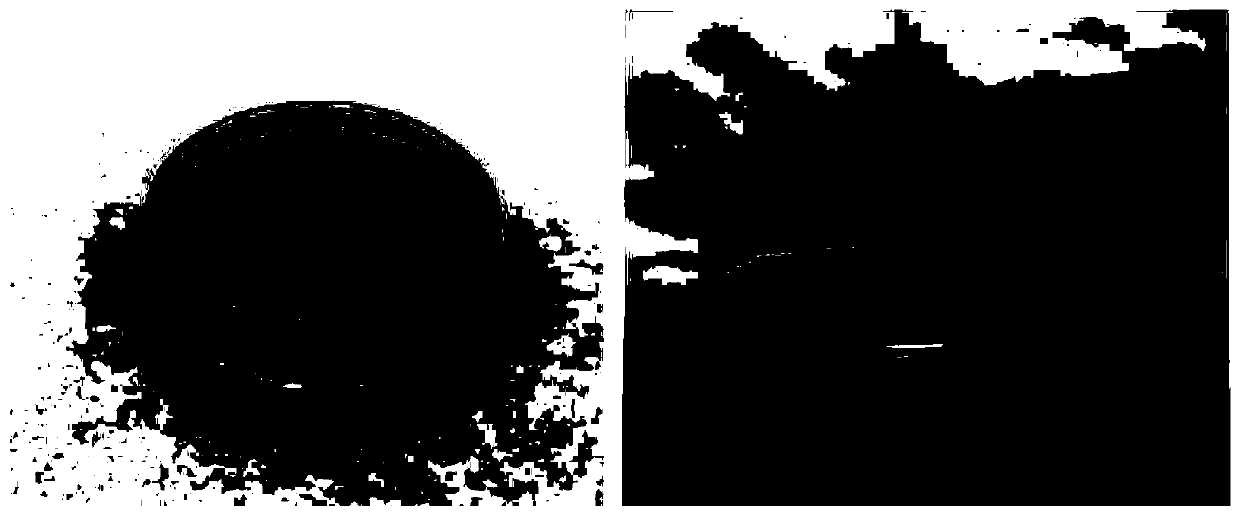Nitrogen-and-phosphorus-atom co-doped CDI active material and preparation and application thereof
An active material and co-doping technology, applied in the field of environmental engineering, can solve the problems of poor material stability, low heteroatom doping efficiency, uneven distribution of heteroatoms, etc., to improve the doping amount, maintain the material structure, improve the electrical The effect of adsorption performance
- Summary
- Abstract
- Description
- Claims
- Application Information
AI Technical Summary
Problems solved by technology
Method used
Image
Examples
Embodiment 1
[0091] Weigh 2g of formula 1-A monomer and dissolve it in 10mL of deionized water, then add 1.68mL of 50% formula 2 solution (mass ratio of formula 1-A: formula 2 is 10:1), stir and mix well to obtain a solution 1. Then weigh 2.202 g of sodium persulfate (the molar ratio of the monomer of formula 1-A to sodium persulfate is 0.5) and dissolve it in 5 mL of deionized water, stir and dissolve to obtain solution 2. Put the two solutions into the refrigerator at the same time for 20 minutes to cool down to below 10°C, then pour them into the petri dish at the same time and shake them quickly to make them fully contact with the reaction, and then let them stand at room temperature for 24 hours. After the reaction was completed, the sample was suction-filtered with deionized water until the filtrate was colorless, and the washed sample was dried at 60°C and collected. The collected material is then placed in a tube furnace, where the N 2 Carbonization at 800 °C for 2 h in the atmos...
Embodiment 2~4
[0093] Adjust the volume of the added solution of Formula 2 to 0mL, 1.12mL and 3.36mL respectively, and the other conditions are the same as in Example 1. The prepared materials are respectively denoted as C-PmPD, C-PmPD@PA-15:1 and C-PmPD@PA-15:1 and C- PmPD@PA-5:1.
Embodiment 5
[0108] Preparation of electrode materials for capacitive desalination
[0109] The polym-phenylenediamine derived nitrogen and phosphorus co-doped carbon material (CDI electrode active material) prepared in embodiment 1-4 and conductive carbon black and binding agent (polyvinylidene fluoride PVDF) according to 8:1:1 The ratio was dissolved in 1 ml of N-methylpyrrolidone solution, then the mixed material was milled for 20 minutes to form a viscous slurry which was coated on a titanium electrode plate. The electrode plate was dried under natural ventilation at room temperature for 12 hours, and then dried in an oven at 120°C for 12 hours to remove all solvents and form a carbon film, and then the CDI electrode material was prepared. The quality of the active material used for electrosorption can be obtained by weighing the mass of the titanium electrode plate before and after coating and calculating the difference, which is controlled at 40±5mg. The area coated with the active m...
PUM
| Property | Measurement | Unit |
|---|---|---|
| Thickness | aaaaa | aaaaa |
| Adsorption capacity | aaaaa | aaaaa |
| Adsorption capacity | aaaaa | aaaaa |
Abstract
Description
Claims
Application Information
 Login to View More
Login to View More - R&D
- Intellectual Property
- Life Sciences
- Materials
- Tech Scout
- Unparalleled Data Quality
- Higher Quality Content
- 60% Fewer Hallucinations
Browse by: Latest US Patents, China's latest patents, Technical Efficacy Thesaurus, Application Domain, Technology Topic, Popular Technical Reports.
© 2025 PatSnap. All rights reserved.Legal|Privacy policy|Modern Slavery Act Transparency Statement|Sitemap|About US| Contact US: help@patsnap.com



